FAQ – RC-Cornet® PLUS
Here you will find answers to frequently asked customer questions regarding the RC-Cornet® PLUS.
What is the RC-Cornet® PLUS?
Advantages of RC-Cornet® PLUS as compared to RC-Cornet®
1. Integrated combination therapy
DThe PLUS model has an integrated connection for ISO-standard nebulisers, for simultaneous respiratory and inhalation therapy. A kit is available for connection of non-standard nebulisers.
2. Four intensities per treatment form
The two treatment forms for dilation of the respiratory tract, to reduce shortness of breath (I) and to clean the airways via the loosening of bronchial phlegm (II), each have four instead of two intensities in the case of RC-Cornet® PLUS. In this manner, you can work with the device in a more accurate and individualised way.
3. More precise settings
Furthermore, RC-Cornet® PLUS has the advantage that its settings and resistances can be pre-set in a more accurate manner when all parts are clicked into place.
4. Added safety
The hose is always correctly positioned thanks to the centering dot and thus offers the highest level of therapy safety.
5. Breathing through the nose and mouth
Thanks to the inhalation valve, the RC-Cornet® PLUS offers the possibility of breathing through the nose or mouth. In general, breathing through the nose is preferred for moisturising purposes. However, this may not be possible for various reasons. Thus, the new PLUS device for breathing through the mouth does not need to be removed.
6. Easier handling
The new hose simplifies the handling and assembly, is easier to mount, and no longer requires an insertion aid. This simplifies handling and reduces waste.
7. Faster drying
The new drying aid allows for faster drying of the hose – this saves time.
8. Long-lasting hose
The new design prevents the hose from rolling or kinking, and ensures that the hose is long-lasting (assuming good care and cleaning are provided).
9. The new shape improves function
Thanks to the new housing design, use of the device is quieter and we feel that the respiratory therapy device is easier to grasp.
10. Inspiratory trainer included
The top part of the RC-Cornet® PLUS (without housing or hose) can be used in setting I as an inspiratory trainer. It allows for training of the “pursed lips”, which result in positive pressure in the bronchi (PEP). PEP breathing helps to slow down the exhalation and keeps the airways open for a longer time. In this manner, more air can be exhaled and irritation of the cough receptors is reduced.
Is there an instruction video for the RC-Cornet® PLUS?
Yes, you can easily find answers to all of your questions in our video:
You are currently viewing a placeholder content from YouTube. To access the actual content, click the button below. Please note that doing so will share data with third-party providers.
What are the differences compared to other PEP / OPEP systems?
The RC-Cornet® family belongs to the oscillating PEP or OPEP systems, which stand out due to their combination of a stabilising exhalation pressure to dilate the respiratory airways and a mobilising exhalation pressure with a high flow rate for secretion remove.
Unlike PEP systems, dilating the airways based on high pressures, the RC-Cornet® PLUS allows
a) a dilation of the respiratory tracts based on a static pressure (once the tube and the body has been detached) in setting I
b) a dilation based on variable pressures (via the tube and the body), an improved gas exchanges as well as a deeper dissolution of phlegm and improving the deposition of drugs through simultaneous inhalation therapy in Setting I.
c) Setting II then allows higher flow rates to mobilize the sticky mucus and to reduce cough.
Tip: All parts fit together. Please do not apply excessive pressure or force during assembly.
What are the differences between RC-Cornet® PLUS NASAL / RC-Cornet® PLUS TRACHEO?
The RC-Cornet® PLUS TRACHEO has an integrated trachea attachment (15mm) that makes respiratory therapy possible directly through the patient’s cannula (tube).
For which diagnoses is the RC-Cornet® PLUS reimbursable in Germany?
1. Chronic obstructive pulmonary disease (COPD)
2. Emphysema
3. Cystic fibrosis
4. Smoker’s cough
5. Asthma
6. Chronic bronchitis
7. Bronchiectasis
8. Diminished retraction force of the lung tissue
Which health insurance companies reimburse the RC-Cornet® PLUS?
Where can I purchase the RC-Cornet® PLUS without a prescription?
Business customers can turn to wholesalers and medical supply stores in their area, or may also procure them directly from us. To do so, please send an e-mail to bestellung@cegla.de.
How long can I use the RC-Cornet® PLUS?
Which parts must be replaced regularly?
With regular use, we recommend that the tube be replaced every six months. The tube can be purchased as a 2-pack at all pharmacies, medical supply stores, and online under PZN 13 058 194 / Article No. 2660 in Germany.
How is the device assembled?
a. Connect the one-way valve with the adapter.
b. Push the mouthpiece into the centre of the adapter.
c. Remove the cleaning aid from the tube.
d. Slide the tube onto the adapter and make sure that the centering dot clicks into the adapter cut-out. Then, guide this assembled part into the body. Please make sure that the arrows on the adapter and on the body are exactly aligned. Check the tube position. It should not be kinked inside the body.
g. Reattach the body lid.
Tip: All parts work as a push-together system, please do not use excessive pressure or force during assembly.
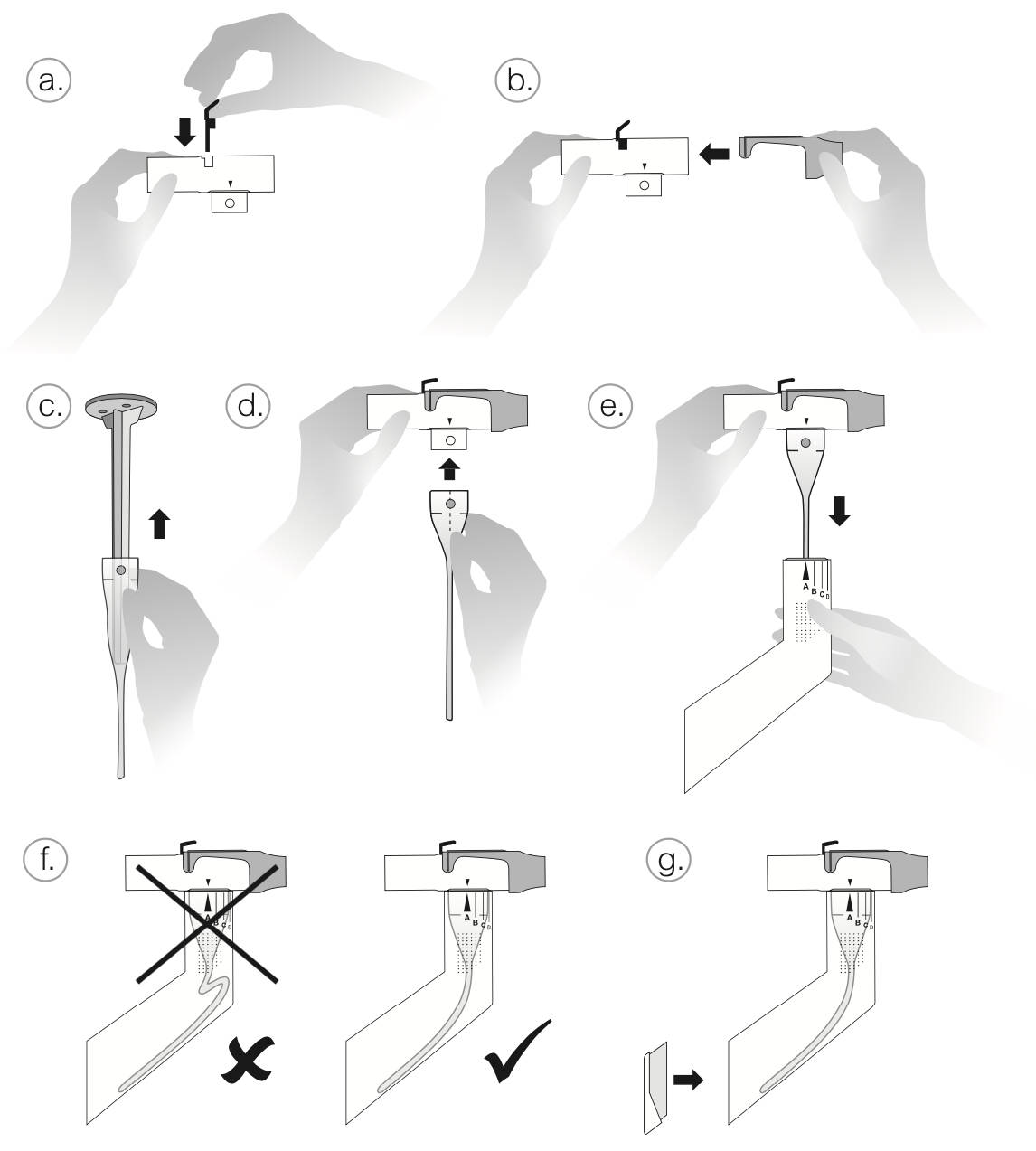
What is the cleaning procedure and how often should it be conducted?
Please wash your hands before cleaning. In order to clean, disassemble the RC-Cornet® PLUS into its individual components as follows. The following order of disassembly is mandatory:
a. Remove the body lid.
b. Pull out the adapter from the body.
c. Remove the mouthpiece from the adapter.
d. Pull the one-way valve out of the adapter.
e. Press the upper section of the tube together and pull the tube out of the adapter.
f.+ g. Insert the cleaning aid into the tube.
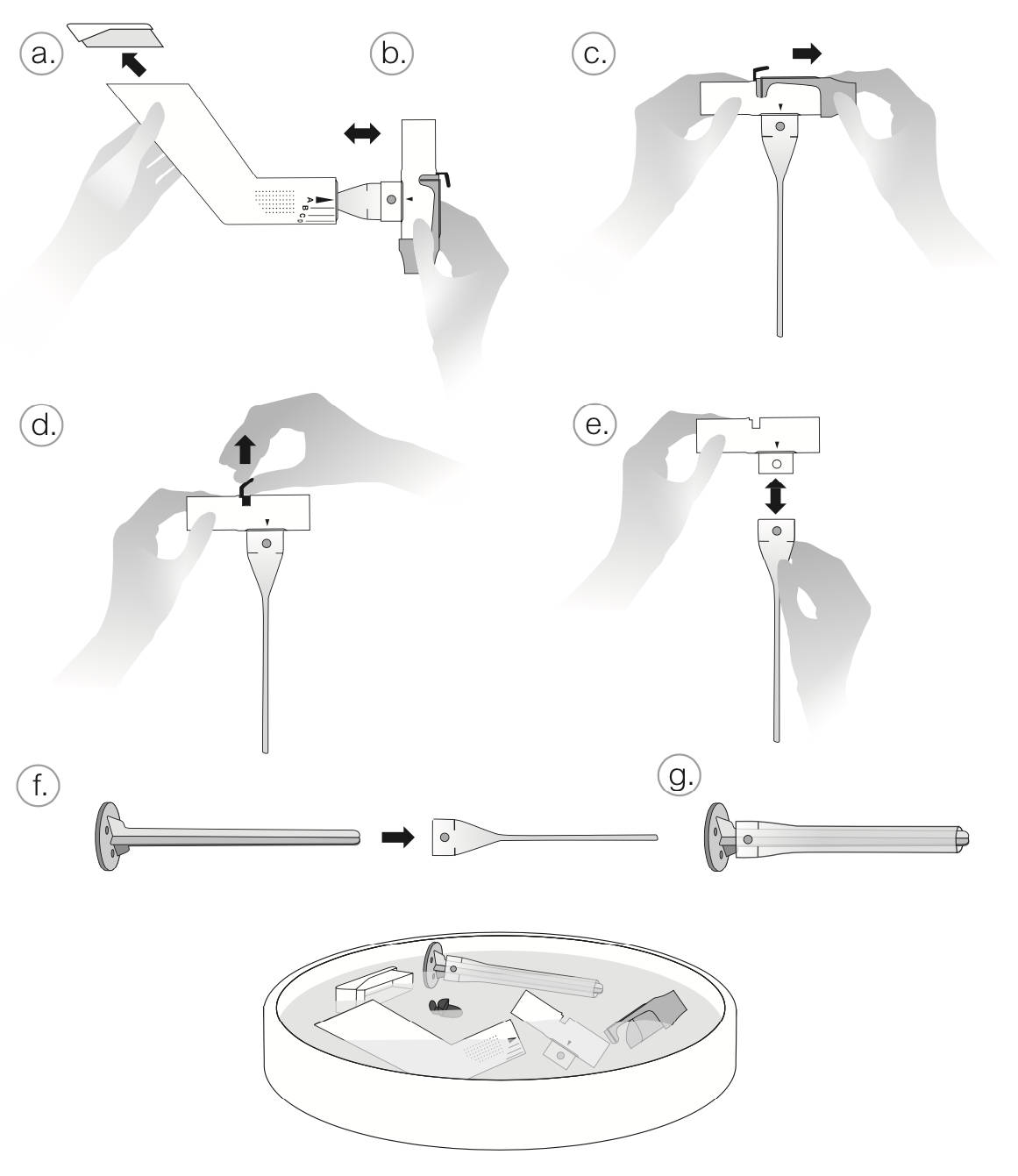
Wash all parts in a solution of lukewarm clean water and standard liquid soap detergent. Rinse with clear water. After this cleaning, all parts may be cleaned in a vaporiser or for approx. 5 minutes in boiling water. Maximum temperature 134°C.
Important! The cleaning aid must remain in the tube during the entire cleaning procedure in order to allow for a thorough cleaning. Clean the device if soiled or after every use, but at least twice weekly.
Note for technical personnel:
Clinical treatment instructions can be found here.
The tube – it’s actually very easy!
How do I mount the tube?
Slide the tube into the adapter and make sure that the centering dot clicks into the adapter cut-out. Then, guide this assembled part into the body. Please make sure that the arrows on the adapter and on the body are exactly aligned.
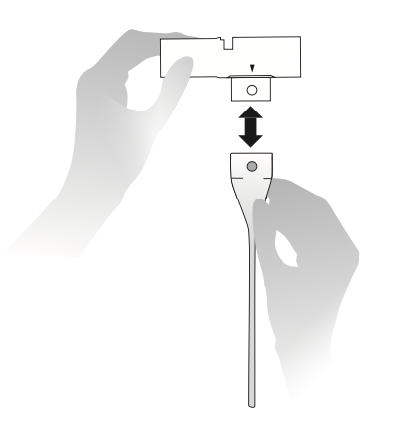
Is the tube properly positioned inside the RC-Cornet® PLUS?
In order to check, shake the RC-Cornet® PLUS. If you can hear the tube moving inside, it is properly positioned. If not, simply remove the body lid and correct the tube compression.
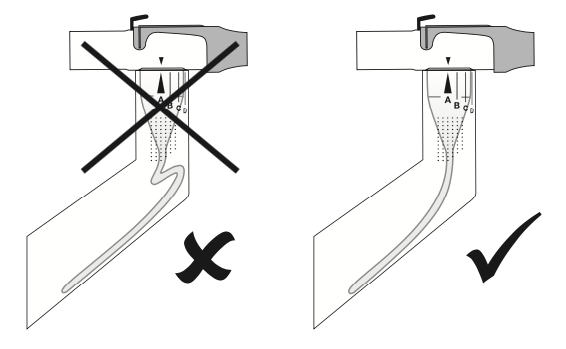
How do I clean the tube correctly and make sure it dries properly?
In order to clean, always slide the tube over the cleaning aid so that it doesn’t stick together. After cleaning, leave the tube on the cleaning aid. Next, simply shake off any excess water. Then, stand the cleaning aid vertically so that the residual liquid can flow downward.

How often should the tube be replaced?
With regular use, we recommend that the tube be replaced every six months. The tube can be purchased as a 2-pack at all pharmacies, medical supply stores, and online under PZN 13 058 194 / Article No. 2660.
Nebulisation/inhalation and the RC-Cornet® PLUS, how does this work?
How do I integrate a nebuliser?
Connect the RC-Cornet® PLUS to your nebuliser. To do so, simply insert the nebuliser directly into the ISO-standard nebuliser attachment. To detach the nebuliser from the adapter, it must be pulled straight out.
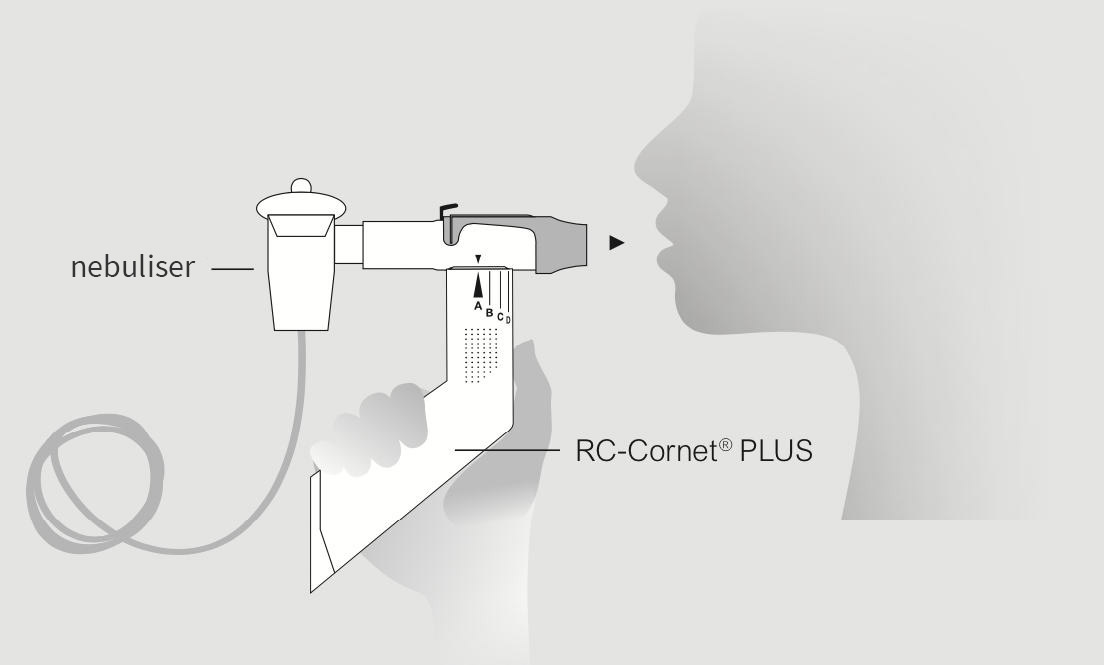
IMPORTANT: Please do not “shake” the nebuliser. This may cause damage.
Which setting do I choose on the RC-Cornet® PLUS for simultaneous nebulisation?
Always use setting 1 on the RC-Cornet® PLUS for combined therapy. This setting opens up the airways. Please inhale and exhale only through the device. The treatment duration will be the nebulisation time.
What should I do if my nebuliser does not fit onto the integrated nebuliser attachment?
We offer the RC-Cornet® PLUS NEBULISER SET as an accessory for non-standard nebulisers.
The scope of delivery does not include a nebuliser or our RC-Cornet® PLUS NEBULISER SET (PZN 14 439 900 / Article No. 2651). Both articles can be purchased separately.
Is simultaneous inhalation mandatory?
No, simultaneous inhalation is not required. It is just an option that we very much recommend: The combination of a respiratory and an inhalation therapy shortens the daily therapy time, improves expectoration and drug deposition.
Settings and resistances, how do I use them correctly for my therapy?
What are the different settings used for?
Setting I: Stabilising exhalation pressure for dilation of the airways / reduction of breathlessness
The completely exhaled air is guided slowly and gently through the smaller opening (stenosis) in the tube and produces a gradual dilation of the airways.

Setting II: Mobilising exhalation pressure with a high flow rate for secretion removal
The opening is enlarged by turning, so that the completely exhaled air reaches the tube quickly and forcefully. The secretions in the respiratory tract are diluted and liquefied as a result and can be easily coughed up.

Different resistances per setting and the complete use of exhaled air allow even very weak patients to benefit from RC-Cornet® PLUS therapy. By setting the resistance levels A-D, the tube twists upon itself. With each setting, the resistance increases gradually in such a manner that the patient exhales against it. This customisability helps many different patient groups to perform efficient respiratory therapy.

Can I work only with the resistances, or can I only use one setting?
The effect of respiratory therapy with the RC-Cornet® PLUS is only efficient and optimised when our recommended therapy is conducted. This means three times a day starting with two minutes in setting I, and then another two minutes in setting II, using the resistance that is optimal for you. If required, you can detach the tube and the body form the adapter so that you can perform a PEP therapy on the way.
If you still have questions, please call us at +49 (0)2602-92 130 or use our contact form.
